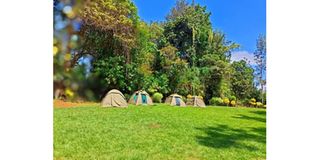Wandering around Wajee Nature Park in Mukuruwe-ini

Camping at Wajee Nature Trail in Mukuruwe-ini. Photo | DESIRE WAINAINA
What you need to know:
After inheriting his land from his father, Mzee Kunyiha Gakunjureturned it its natural state
“It was forest around here,” tells Mzee Kunyiha Gakunju. At 93, Mzee Gakunju has a crystal clear memory, walks several miles a day and needless to say – is fit as a fiddle. He’s the eldest brother of Jagi Gakunju, the author of ‘Living on the Edge’ a memoir of youth, the political turmoil before Kenya’s independence, adventures, travels and work in conservation. Today he sits on several conservation boards such as the African Fund for Endangered Wildlife (Giraffe Centre) and the Wildlife Clubs of Kenya.
We’re relaxing under the shade of the enormous 300-year-old Newtonia buchananii, its canopy so wide that it shades the lawn where children from a nearby school in Mukuruwe-ini have had a field day in the nature trail that boasts little creatures like the dikdik and chameleons plus the ‘bird only found in Kenya’ the Hinde’s Babbler. This little bird likes the forest scrub and its stronghold defines Mukuruwe-ini region, Central Kenya. In recent years as Kenyans take increasingly to birding, they have recently been seen in Thika and Nairobi’s lusher side.

Wajee Nature Trail in Mukuruwe-ini. Photo | DESIRE WAINAINA
“Our father bought this land from another family in the area,” continues Mzee Gakunju.
In a distant gaze, he takes us to his youth. In 1941, their father – Reverend James Gakunju – put up his stone house for his wife Mumbi and young family. The older children like Mzee Gakunju were in boarding school run by Scottish missionaries in nearby Tumutumu.
“It was bushland all around and there were few people. My father kept cows,” continues Mzee Gakunju.
It’s a fascinating morning listening to Mzee Gakunju having lived through the days of the Mau Mau freedom fighters, and the bitter-sweet road to Kenya’s independence. This is a story for another day.
The dairy farm prospered and the respected Reverend bequeathed the farm to his children.
On inheriting his piece of land, Gakunju decided to let it return to its natural state that was a forest. His first step was to get rid of the exotic eucalyptus trees and replace them with local indigenous ones like the Meru oaks, Podo, Cape Mahogany and more.
After two decades of ‘rewilding’, Wajee Nature Park boasts the only indigenous forest surrounded by farms.
A Walk on the Wild Side

Gacheke Jennifer Simmons founder of Yogi Hikers on the Aberdares. Courtesy Desire Wainaina June 2022. Photo | Pool
The walk into the forest goes past Waji House with the year 1941 inscribed on it. It’s in its original ‘mabati’ tin roof and the stone work so solid that nothing has shaken it in the ensuing years.
The forest is serene with its tall trees and hanging vines, the undergrowth rich in sound of the forest birds. “That’s the Yellow-whiskered Greenbul or as we call it the ‘forest noisemaker’,” tells Robert Muchunu the manager cum naturalist at Wajee. The trail on the red earth is rich with the morning dew, the siafu or the safari ants coming out for the sun. We have to step over the siafu trails but these ants are indispensible to healthy forests, chewing up the fallen leaves and all dead matter. Between Muchunu and Desire Wainaina the young neighbour, we log on more forest species. The Hinde’s Babbler remains elusive on this cold morning just sending out calls to let us know its’ around.
The trail goes down into the valley with a rich swamp and open glades of grassland and then up again where Muchunu leads us deeper into the forest to show the ‘hanging tree’.
It’s a Eucalyptus saligna, one of the few exotic trees that has survived, massive of girth and height. Looking up, a few feet from it, is the ‘hanging tree’ like a pendulum. “This tree, is joined to the mother tree from the top branch and receives all its nutrients from her.”
Walking out of the forest a few hours later, we’re met by Tom Macharia busy composting the forest leaves and kitchen waste. He points to his compost pits and honey combs, stating, “Good compost feeds the soil.” From a healthy base grows the plant.
His compost is attracting the coffee farmers around. “The natural compost is more economical than the chemical fertiliser, as it doesn’t destroy the soil, and the coffee beans are bigger, taste better and fetch more money in the market because they are organic.”
And then he brings out the organic honey, from the bees in the forest – its taste so pure that I’m sold.
More on Wajee - https://wajeenaturepark.co.ke/
It’s a scenic road from Nairobi via Muranga to Wajee along the rice paddies and local Kikuyu towns – 180 kms. At Wajee, enjoy the many hikes through the countryside to the waterfalls and meadows. It’s affordable with great home cooked meals around the fire-place.
Travel further to the Aberdares, entering through the Wandare Gate.




